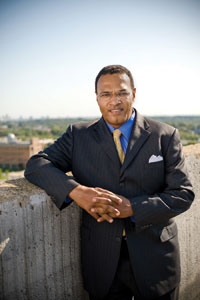
UMBC President Freeman A. Hrabowski, III, takes your questions.
Q. How does UMBC prepare students for the real world? What is UMBC doing to instill a work ethic in students?
Q. I’m curious to know what UMBC is doing for its students and alumni in helping them to bridge the “backpack to briefcase” gap between the academic world and the professional world? How is UMBC helping students to prepare for professional careers even while they are still students? And, is it enough? What more can be done?
A. I think the most important strategy we’ve been using for years is getting students involved in internships. Students who have the opportunity to work in companies, in national agencies, and in schools get a sense of what’s important in the workplace. They also learn how to deal with other people. They come to understand that getting an “A” is not enough. You have to be able to collaborate.
And most important, they have the opportunity to see the relationship between expectations in the workplace and the work they’re doing in the classroom – whether it’s in computing or in the broad liberal arts. Students who work as interns or in part-time jobs are far more realistic about what’s possible after college – and far more proactive in seeking interviews for possible jobs. What’s really exciting is that a large number of our students who work as interns are offered full time work even before they graduate.
As far as preparing students, we have the Shriver Center – which encourages students to take advantage of resources on campus for developing a resume, knowing what jobs are available, and for discussing with advisors what kinds of positions one might apply for. And we have the Office of Career Services, which works with people in obtaining both full-time and part-time opportunities. Both offices are very important. They are involved in building partnerships. They can be very helpful to students – and to alumni, who in many cases are coming back for career days and other services.
The Social Security Administration was on campus on April 29. That agency is hiring 5,000 people in the next five months. Twenty percent of the jobs will be on Security Boulevard. It’s an exciting prospect.
Q. What are your feelings on the Obama administration’s initiatives related to science and how do you think they will impact the ongoing programs and initiatives at UMBC and the current graduating class?
A. I’m fortunate now to be chairing the National Academies of Science Committee on Underrepresented Groups and the Expansion of the Science and Engineering Workforce Pipeline. So I get a chance to see the official papers of this administration, and to listen to the different national agencies talk about particular initiatives designed to broaden participation in science and engineering. I also had the privilege of reading President Obama’s April 29 speech on investment in science fairly early.
What’s very clear is that the president and his advisors agree that we will need to do much more to encourage students to excel in sciences. We need to strengthen math and science teaching at the K-12 level. We need to get more people to think about becoming math and science teachers. And we need to strengthen teaching and learning at the college level to ensure that students remain in science. Our Chemistry Discovery Center, which is funded by the National Science Foundation and the UMBC Annual Fund, is designed exactly for that purpose.
UMBC is uniquely positioned in our country right now to contribute in two broad ways. We produce the highest percentage of students in science and engineering in the University System of Maryland – and the highest of any school, private or public, in the state with the exception of the U.S. Naval Academy. Forty-five percent of our bachelor’s degrees are awarded in science and engineering.
At the same time, UMBC is producing hundreds of liberally-educated students across disciplines. Our society will need both to ensure that America’s future is bright.
Tags: Summer 2009
